Spatiotemporal Dynamics and Driving Factors of Ecosystem Services Value in the Hexi Regions, Northwest China
Abstract
:1. Introduction
2. Materials and Methods
2.1. Study Area
2.2. Data Sources
2.3. Methods
2.3.1. Estimation of the ESV
2.3.2. Land Use Simulation
2.3.3. Trade-Offs and Synergies Analysis Method
2.3.4. Geographical Detector Analysis
3. Results
3.1. The Spatiotemporal Changes of the ESV
3.2. Trade-Offs and Synergies among Ecosystem Services Based on ESV
3.3. Drivers of Ecosystem Services Value
4. Discussion
4.1. Changes in the ESV in Different Regions
4.2. The Synergies and Trade-Offs Relationships of Ecosystem Services
4.3. Drivers of the ESV
4.4. Management Implication and Limitation
5. Conclusions
Supplementary Materials
Author Contributions
Funding
Institutional Review Board Statement
Informed Consent Statement
Data Availability Statement
Acknowledgments
Conflicts of Interest
References
- Costanza, R.; D’Arge, R.; de Groot, R.; Farber, S.; Grasso, M.; Hannon, B.; Limburg, K.; Naeem, S.; O’Neill, R.V.; Paruelo, J.; et al. The value of the world’ s ecosystem services and natural capital. Nature 1997, 387, 253–260. [Google Scholar] [CrossRef]
- Millennium Ecosystem Assessment, M.E.A. Ecosystems and Human Well-Being; Island Press: Washington, DC, USA, 2005. [Google Scholar]
- Daw, T.; Brown, K.; Rosendo, S.; Pomeroy, R. Applying the ecosystem services concept to poverty alleviation: The need to disaggregate human well-being. Environ. Conserv. 2011, 38, 370–379. [Google Scholar] [CrossRef] [Green Version]
- Sannigrahi, S.; Chakraborti, S.; Joshi, P.K.; Keesstra, S.; Sen, S.; Paul, S.K.; Kreuter, U.; Sutton, P.C.; Jha, S.; Dang, K.B. Ecosystem service value assessment of a natural reserve region for strengthening protection and conservation. J. Environ. Manag. 2019, 244, 208–227. [Google Scholar] [CrossRef] [PubMed]
- Laurans, Y.; Rankovic, A.; Bille, R.; Pirard, R.; Mermet, L. Use of ecosystem services economic valuation for decision making: Questioning a literature blindspot. J. Environ. Manag. 2013, 119, 208–219. [Google Scholar] [CrossRef]
- Xie, G.; Zhang, C.; Zhen, L.; Zhang, L. Dynamic changes in the value of China’s ecosystem services. Ecosyst. Serv. 2017, 26, 146–154. [Google Scholar] [CrossRef]
- Naselli-Flores, L.; Padisák, J. Ecosystem services provided by marine and freshwater phytoplankton. Hydrobiologia 2022. [Google Scholar] [CrossRef] [PubMed]
- Costanza, R.; de Groot, R.; Sutton, P.; van der Ploeg, S.; Anderson, S.J.; Kubiszewski, I.; Farber, S.; Turner, R.K. Changes in the global value of ecosystem services. Glob. Environ. Chang. 2014, 26, 152–158. [Google Scholar] [CrossRef]
- Díaz, S.; Settele, J.; Brondízio, E.S.; Ngo, H.T.; Agard, J.; Arneth, A.; Balvanera, P.; Brauman, K.A.; Butchart, S.H.M.; Chan, K.M.A.; et al. Pervasive human-driven decline of life on Earth points to the need for transformative change. Science 2019, 366, x3100. [Google Scholar] [CrossRef] [Green Version]
- Xiao, Y.; Huang, M.; Xie, G.; Zhen, L. Evaluating the impacts of land use change on ecosystem service values under multiple scenarios in the Hunshandake region of China. Sci. Total Environ. 2022, 850, 158067. [Google Scholar] [CrossRef]
- He, X.; Liang, J.; Zeng, G.; Yuan, Y.; Li, X. The Effects of Interaction between Climate Change and Land-Use/Cover Change on Biodiversity-Related Ecosystem Services. Glob. Chall. 2019, 3, 1800095. [Google Scholar] [CrossRef]
- Zhang, L.; Lü, Y.; Fu, B.; Zeng, Y. Uncertainties of Two Methods in Selecting Priority Areas for Protecting Soil Conservation Service at Regional Scale. Sustainability 2017, 9, 1577. [Google Scholar] [CrossRef] [Green Version]
- Berihun, M.L.; Tsunekawa, A.; Haregeweyn, N.; Meshesha, D.T.; Adgo, E.; Tsubo, M.; Masunaga, T.; Fenta, A.A.; Sultan, D.; Yibeltal, M. Exploring land use/land cover changes, drivers and their implications in contrasting agro-ecological environments of Ethiopia. Land Use Policy 2019, 87, 104052. [Google Scholar] [CrossRef]
- Schirpke, U.; Kohler, M.; Leitinger, G.; Fontana, V.; Tasser, E.; Tappeiner, U. Future impacts of changing land-use and climate on ecosystem services of mountain grassland and their resilience. Ecosyst. Serv. 2019, 26, 79–94. [Google Scholar] [CrossRef] [PubMed]
- Allan, E.; Manning, P.; Alt, F.; Binkenstein, J.; Blaser, S.; Blüthgen, N.; Böhm, S.; Grassein, F.; Hölzel, N.; Klaus, V.H.; et al. Land use intensification alters ecosystem multifunctionality via loss of biodiversity and changes to functional composition. Ecol. Lett. 2015, 18, 834–843. [Google Scholar] [CrossRef] [PubMed] [Green Version]
- Li, W.; Wang, L.; Yang, X.; Liang, T.; Zhang, Q.; Liao, X.; White, J.R.; Rinklebe, J. Interactive influences of meteorological and socioeconomic factors on ecosystem service values in a river basin with different geomorphic features. Sci. Total Environ. 2022, 829, 154595. [Google Scholar] [CrossRef] [PubMed]
- Su, K.; Wei, D.; Lin, W. Evaluation of ecosystem services value and its implications for policy making in China – A case study of Fujian province. Ecol. Indic. 2020, 108, 105752. [Google Scholar] [CrossRef]
- Ouyang, Z.; Song, C.; Zheng, H.; Polasky, S.; Xiao, Y.; Bateman, I.J.; Liu, J.; Ruckelshaus, M.; Shi, F.; Xiao, Y.; et al. Using gross ecosystem product (GEP) to value nature in decision making. Proc. Natl. Acad. Sci. USA 2020, 117, 14593–14601. [Google Scholar] [CrossRef]
- Boumans, R.; Roman, J.; Altman, I.; Kaufman, L. The Multiscale Integrated Model of Ecosystem Services (MIMES): Simulating the interactions of coupled human and natural systems. Ecosyst. Serv. 2015, 12, 30–41. [Google Scholar] [CrossRef]
- Xie, G.; Zhen, L.; Lu, C.; Xiao, Y.; Chen, C. Expert Knowledge Based Valuation Method of Ecosystem Services in China. J. Nat. Resour. 2008, 23, 911–919. [Google Scholar]
- Han, X.; Yu, J.; Shi, L.; Zhao, X.; Wang, J. Spatiotemporal evolution of ecosystem service values in an area dominated by vegetation restoration: Quantification and mechanisms. Ecol. Indic. 2021, 131, 108191. [Google Scholar] [CrossRef]
- Bagstad, K.J.; Semmens, D.J.; Waage, S.; Winthrop, R. A comparative assessment of decision-support tools for ecosystem services quantification and valuation. Ecosyst. Serv. 2013, 5, 27–39. [Google Scholar] [CrossRef]
- Kusi, K.K.; Khattabi, A.; Mhammdi, N.; Lahssini, S. Prospective evaluation of the impact of land use change on ecosystem services in the Ourika watershed, Morocco. Land Use Policy 2020, 97, 104796. [Google Scholar] [CrossRef]
- Song, W.; Deng, X. Land-use/land-cover change and ecosystem service provision in China. Sci. Total Environ. 2017, 576, 705–719. [Google Scholar] [CrossRef]
- de Oliveira Barros, K.; Alvares Soares Ribeiro, C.A.; Marcatti, G.E.; Lorenzon, A.S.; Martins De Castro, N.L.; Domingues, G.F.; Romário De Carvalho, J.; Rosa Dos Santos, A. Markov chains and cellular automata to predict environments subject to desertification. J. Environ. Manag. 2018, 225, 160–167. [Google Scholar] [CrossRef] [PubMed]
- Gao, X.; Wang, J.; Li, C.; Shen, W.; Song, Z.; Nie, C.; Zhang, X. Land use change simulation and spatial analysis of ecosystem service value in Shijiazhuang under multi-scenarios. Environ. Sci. Pollut. Res. Int. 2021, 28, 31043–31058. [Google Scholar] [CrossRef]
- Lang, Y.; Song, W. Quantifying and mapping the responses of selected ecosystem services to projected land use changes. Ecol. Indic. 2019, 102, 186–198. [Google Scholar] [CrossRef]
- Li, X.; Chen, Y.; Liu, X.; Li, D.; He, J. Concepts, methodologies, and tools of an integrated geographical simulation and optimization system. Int. J. Geogr. Inf. Sci. 2011, 25, 633–655. [Google Scholar] [CrossRef] [Green Version]
- Hou, J.; Qin, T.; Liu, S.; Wang, J.; Dong, B.; Yan, S.; Nie, H. Analysis and Prediction of Ecosystem Service Values Based on Land Use/Cover Change in the Yiluo River Basin. Sustainability 2021, 13, 6432. [Google Scholar] [CrossRef]
- Liang, X.; Guan, Q.; Clarke, K.C.; Chen, G.; Guo, S.; Yao, Y. Mixed-cell cellular automata: A new approach for simulating the spatio-temporal dynamics of mixed land use structures. Landsc. Urban Plan 2021, 205, 103960. [Google Scholar] [CrossRef]
- Li, C.; Wu, Y.; Gao, B.; Zheng, K.; Wu, Y.; Li, C. Multi-scenario simulation of ecosystem service value for optimization of land use in the Sichuan-Yunnan ecological barrier, China. Ecol. Indic. 2021, 132, 108328. [Google Scholar] [CrossRef]
- Liang, X.; Guan, Q.F.; Clarke, K.C.; Liu, S.S.; Wang, B.Y.; Yao, Y. Understanding the drivers of sustainable land expansion using a patch-generating land use simulation (PLUS) model: A case study in Wuhan, China. Comput. Environ. Urban. Syst. 2021, 85, 101569. [Google Scholar] [CrossRef]
- Bennett, E.M.; Peterson, G.D.; Gordon, L.J. Understanding relationships among multiple ecosystem services. Ecol. Lett. 2009, 12, 1394–1404. [Google Scholar] [CrossRef] [PubMed]
- Chen, T.; Peng, L.; Wang, Q. Response and multiscenario simulation of trade-offs/synergies among ecosystem services to the Grain to Green Program: A case study of the Chengdu-Chongqing urban agglomeration, China. Environ. Sci. Pollut. Res. 2022, 29, 33572–33586. [Google Scholar] [CrossRef] [PubMed]
- Dade, M.C.; Mitchell, M.G.E.; McAlpine, C.A.; Rhodes, J.R. Assessing ecosystem service trade-offs and synergies: The need for a more mechanistic approach. Ambio 2019, 48, 1116–1128. [Google Scholar] [CrossRef]
- Zheng, D.; Wang, Y.; Hao, S.; Xu, W.; Lv, L.; Yu, S. Spatial-temporal variation and tradeoffs/synergies analysis on multiple ecosystem services: A case study in the Three-River Headwaters region of China. Ecol. Indic. 2020, 116, 106494. [Google Scholar] [CrossRef]
- Li, Y.; Liu, W.; Feng, Q.; Zhu, M.; Yang, L.; Zhang, J. Quantitative Assessment for the Spatiotemporal Changes of Ecosystem Services, Tradeoff–Synergy Relationships and Drivers in the Semi-Arid Regions of China. Remote Sens. 2022, 14, 239. [Google Scholar] [CrossRef]
- Yao, J.; Liu, H.; Huang, J.; Gao, Z.; Wang, G.; Li, D.; Yu, H.; Chen, X. Accelerated dryland expansion regulates future variability in dryland gross primary production. Nat. Commun. 2020, 11, 1665. [Google Scholar] [CrossRef] [Green Version]
- Qian, D.; Yan, C.; Xing, Z.; Xiu, L. Monitoring coal mine changes and their impact on landscape patterns in an alpine region: A case study of the Muli coal mine in the Qinghai-Tibet Plateau. Environ. Monit. Assess. 2017, 189, 513–559. [Google Scholar] [CrossRef]
- Zhou, Z.; Han, N.; Liu, J.; Yan, Z.; Xu, C.; Cai, J.; Shang, Y.; Zhu, J. Glacier variations and their response to climate change in an arid inland river basin of Northwest China. J. Arid Land. 2020, 12, 357–373. [Google Scholar] [CrossRef]
- Pan, N.; Guan, Q.; Wang, Q.; Sun, Y.; Li, H.; Ma, Y. Spatial Differentiation and Driving Mechanisms in Ecosystem Service Value of Arid Region: A case study in the middle and lower reaches of Shule River Basin, NW China. J. Clean. Prod. 2021, 319, 128718. [Google Scholar] [CrossRef]
- Feng, Q.; Yang, L.S.; Deo, R.C.; AghaKouchak, A.; Adamowski, J.F.; Stone, R.; Yin, Z.L.; Liu, W.; Si, J.H.; Wen, X.H.; et al. Domino effect of climate change over two millennia in ancient China’s Hexi Corridor. Nat. Sustain. 2019, 2, 957–961. [Google Scholar] [CrossRef]
- He, J.; Wang, N.; Chen, A.A.; Yang, X.; Hua, T. Glacier Changes in the Qilian Mountains, Northwest China, between the 1960s and 2015. Water 2019, 11, 623. [Google Scholar] [CrossRef] [Green Version]
- Li, Y.; Liu, W.; Feng, Q.; Zhu, M.; Yang, L.; Zhang, J.; Yin, X. The role of land use change in affecting ecosystem services and the ecological security pattern of the Hexi Regions, Northwest China. Sci. Total Environ. 2023, 855, 158940. [Google Scholar] [CrossRef] [PubMed]
- Li, Y.; Liu, W.; Feng, Q.; Zhu, M.; Yang, L.; Zhang, J. Effects of land use and land cover change on soil organic carbon storage in the Hexi regions, Northwest China. J. Environ. Manag. 2022, 312, 114911. [Google Scholar] [CrossRef] [PubMed]
- Peng, S.Z.; Ding, Y.X.; Liu, W.Z.; Li, Z. 1 km monthly temperature and precipitation dataset for China from 1901 to 2017. Earth Syst. Sci. Data 2019, 11, 1931–1946. [Google Scholar] [CrossRef] [Green Version]
- Milly, P.C.D.; Dunne, K.A. Potential evapotranspiration and continental drying. Nat. Clim. Chang. 2016, 6, 946–949. [Google Scholar] [CrossRef]
- Peng, S. 1 km Multi-Scenario and Multi-Model Monthly Temperature Data for China in 2021–2100; National Tibetan Plateau Data Center: Beijing, China, 2022. [Google Scholar]
- Peng, S. 1 km Multi-Scenario and Multi-Model Monthly Precipitation Data for China in 2021–2100; National Tibetan Plateau Data Center: Beijing, China, 2022. [Google Scholar]
- Zhu, M.; Zhang, C.Q.; Zhang, J.T. 30 m Grid Data of 0–100 cm Soil Organic Carbon Density in Qilian Mountains; National Cryosphere Desert Data Center: Lanzhou, China, 2021. [Google Scholar]
- Jiang, T.; Su, B.; Wang, Y.; Wang, G.; Luo, Y.; Zhai, J.Q.; Huang, J.; Jing, C.; Gao, M.; Lin, Q.; et al. Gridded datasets for population and economy under Shared Socioeconomic Pathways for 2020–2100. Clim. Chang. Res. 2022, 18, 381–383. [Google Scholar]
- Xie, G.; Zhang, C.; Zhang, L.; Chen, W.; Li, S. Improvement of the Evaluation Method for Ecosystem Service Value Based on Per Unit Area. J. Nat. Resour. 2015, 30, 1243–1254. [Google Scholar]
- Riahi, K.; van Vuuren, D.P.; Kriegler, E.; Edmonds, J.; O Neill, B.C.; Fujimori, S.; Bauer, N.; Calvin, K.; Dellink, R.; Fricko, O.; et al. The Shared Socioeconomic Pathways and their energy, land use, and greenhouse gas emissions implications: An overview. Glob. Environ. Chang. 2017, 42, 153–168. [Google Scholar] [CrossRef] [Green Version]
- Zhang, S.; Yang, P.; Xia, J.; Wang, W.; Cai, W.; Chen, N.; Hu, S.; Luo, X.; Li, J.; Zhan, C. Land use/land cover prediction and analysis of the middle reaches of the Yangtze River under different scenarios. Sci. Total Environ. 2022, 833, 155238. [Google Scholar] [CrossRef]
- Jiang, C.; Guo, H.; Wei, Y.; Yang, Z.; Wang, X.; Wen, M.; Yang, L.; Zhao, L.; Zhang, H.; Zhou, P. Ecological restoration is not sufficient for reconciling the trade-off between soil retention and water yield: A contrasting study from catchment governance perspective. Sci. Total Environ. 2021, 754, 142139. [Google Scholar] [CrossRef] [PubMed]
- Anselin, L. Local Indicators of Spatial Association-LISA. Geogr. Anal. 1995, 27, 93–115. [Google Scholar] [CrossRef]
- Gaither, C.J.; Poudyal, N.C.; Goodrick, S.; Bowker, J.M.; Malone, S.; Gan, J. Wildland fire risk and social vulnerability in the Southeastern United States: An exploratory spatial data analysis approach. Forest Policy Econ. 2011, 13, 24–36. [Google Scholar] [CrossRef]
- Qian, C.; Gong, J.; Zhang, J.; Liu, D.; Ma, X. Change and tradeoffs-synergies analysis on watershed ecosystem services: A case study of Bailongjiang Watershed, Gansu. Acta Geogr. Sin. 2018, 73, 868–879. [Google Scholar]
- Wang, J.F.; Li, X.H.; Christakos, G.; Liao, Y.L.; Zhang, T.; Gu, X.; Zheng, X.Y. Geographical Detectors-Based Health Risk Assessment and its Application in the Neural Tube Defects Study of the Heshun Region, China. Int. J. Geogr. Inf. Sci. 2010, 24, 107–127. [Google Scholar] [CrossRef]
- Wang, J.F.; Xu, C.D. Geodetector: Principle and prospective. Acta Geogr. Sin. 2017, 72, 116–134. [Google Scholar]
- Li, C.; Wu, X.; Sheridan, S.; Lee, J.; Wang, X.; Yin, J.; Han, J. Interaction of climate and socio-ecological environment drives the dengue outbreak in epidemic region of China. PLoS Negl. Trop. Dis. 2021, 15, e9761. [Google Scholar] [CrossRef]
- Liu, C.; Wang, C.; Li, Y.; Wang, Y. Spatiotemporal differentiation and geographic detection mechanism of ecological security in Chongqing, China. Glob. Ecol. Conserv. 2022, 35, e2072. [Google Scholar] [CrossRef]
- Forthofer, R.N.; Lee, E.S.; Hernandez, M. 13—Linear Regression. Biostatistics (Second Edition); Elsevier Inc: Amsterdam, The Netherlands, 2007; pp. 349–386. [Google Scholar]
- Zhou, X.; Wen, H.; Zhang, Y.; Xu, J.; Zhang, W. Landslide susceptibility mapping using hybrid random forest with GeoDetector and RFE for factor optimization. Geosci. Front. 2021, 12, 101211. [Google Scholar] [CrossRef]
- Zhao, R.; Zhan, L.; Yao, M.; Yang, L. A geographically weighted regression model augmented by Geodetector analysis and principal component analysis for the spatial distribution of PM2.5. Sustain. Cities Soc. 2020, 56, 102106. [Google Scholar] [CrossRef]
- Wang, B.; Li, X.; Ma, C.F.; Zhu, G.F.; Luan, W.F.; Zhong, J.T.; Tan, M.B.; Fu, J. Uncertainty analysis of ecosystem services and implications for environmental management - An experiment in the Heihe River Basin, China. Sci. Total Environ. 2022, 821, 153481. [Google Scholar] [CrossRef] [PubMed]
- Huang, L.; He, C.; Wang, B. Study on the spatial changes concerning ecosystem services value in Lhasa River Basin, China. Environ. Sci. Pollut. R 2022, 29, 7827–7843. [Google Scholar] [CrossRef] [PubMed]
- Aziz, T. Changes in land use and ecosystem services values in Pakistan, 1950–2050. Environ. Dev. 2021, 37, 100576. [Google Scholar] [CrossRef]
- Qian, D.; Yan, C.; Xiu, L.; Feng, K. The impact of mining changes on surrounding lands and ecosystem service value in the Southern Slope of Qilian Mountains. Ecol. Complex. 2018, 36, 138–148. [Google Scholar] [CrossRef]
- Peng, K.; Jiang, W.; Ling, Z.; Hou, P.; Deng, Y. Evaluating the potential impacts of land use changes on ecosystem service value under multiple scenarios in support of SDG reporting: A case study of the Wuhan urban agglomeration. J. Clean. Prod. 2021, 307, 127321. [Google Scholar] [CrossRef]
- Yang, R.; Ren, F.; Xu, W.; Ma, X.; Zhang, H.; He, W. China’s ecosystem service value in 1992–2018: Pattern and anthropogenic driving factors detection using Bayesian spatiotemporal hierarchy model. J. Environ. Manag. 2022, 302, 114089. [Google Scholar] [CrossRef]
- Chen, W.; Chi, G. Ecosystem services trade-offs and synergies in China, 2000–2015. Int. J. Environ. Sci. Technol. 2022, 1–17. [Google Scholar] [CrossRef]
- Li, G.; Fang, C.; Wang, S. Exploring spatiotemporal changes in ecosystem-service values and hotspots in China. Sci. Total Environ. 2016, 545–546, 609–620. [Google Scholar] [CrossRef]
- Liu, H.; Zheng, L.; Wu, J.; Liao, Y. Past and future ecosystem service trade-offs in Poyang Lake Basin under different land use policy scenarios. Arab. J. Geosci. 2020, 13, 46. [Google Scholar] [CrossRef] [Green Version]
- Zhang, Z.; Liu, L.; He, X.; Li, Z.; Wang, P. Evaluation on glaciers ecological services value in the Tianshan Mountains, Northwest China. J. Geogr. Sci. 2019, 29, 101–114. [Google Scholar] [CrossRef] [Green Version]
- Pan, J.; Wei, S.; Li, Z. Spatiotemporal pattern of trade-offs and synergistic relationships among multiple ecosystem services in an arid inland river basin in NW China. Ecol. Indic. 2020, 114, 106345. [Google Scholar] [CrossRef]
- Hulvey, K.B.; Mellon, C.D.; Kleinhesselink, A.R. Rotational grazing can mitigate ecosystem service trade-offs between livestock production and water quality in semi-arid rangelands. J. Appl. Ecol. 2021, 58, 2113–2123. [Google Scholar] [CrossRef]
- Shi, M.; Wu, H.; Fan, X.; Jia, H.; Dong, T.; He, P.; Baqa, M.F.; Jiang, P. Trade-Offs and Synergies of Multiple Ecosystem Services for Different Land Use Scenarios in the Yili River Valley, China. Sustainability 2021, 13, 1577. [Google Scholar] [CrossRef]
- Li, J.; Dong, S.; Li, Y.; Wang, Y.; Li, Z.; Li, F. Effects of land use change on ecosystem services in the China–Mongolia–Russia economic corridor. J. Clean. Prod. 2022, 360, 132175. [Google Scholar] [CrossRef]
- Bie, Q.; Xie, Y.W. The constraints and driving forces of oasis development in arid region: A case study of the Hexi Corridor in northwest China. Sci. Rep. 2020, 10, 17708. [Google Scholar] [CrossRef]
- Li, R.; Zheng, H.; Polasky, S.; Hawthorne, P.L.; O Connor, P.; Wang, L.; Li, R.; Xiao, Y.; Wu, T.; Ouyang, Z. Ecosystem restoration on Hainan Island: Can we optimize for enhancing regulating services and poverty alleviation? Environ. Res. Lett. 2020, 15, 84039. [Google Scholar] [CrossRef]
- Wen, Z.; Wu, J.; Yang, Y.; Li, R.; Ouyang, Z.; Zheng, H. Implementing intercropping maintains soil water balance while enhancing multiple ecosystem services. Catena 2022, 217, 106426. [Google Scholar] [CrossRef]
- Wu, J.; Wang, G.; Chen, W.; Pan, S.; Zeng, J. Terrain gradient variations in the ecosystem services value of the Qinghai-Tibet Plateau, China. Glob. Ecol. Conserv. 2022, 34, e2008. [Google Scholar] [CrossRef]
- Kusi, K.K.; Khattabi, A.; Mhammdi, N. Analyzing the impact of land use change on ecosystem service value in the main watersheds of Morocco. Environ. Dev. Sustain. 2022, 1–28. [Google Scholar] [CrossRef]
- Fang, J.; Song, H.; Zhang, Y.; Li, Y.; Liu, J. Climate-dependence of ecosystem services in a nature reserve in northern China. PLoS ONE 2018, 13, e192727. [Google Scholar] [CrossRef]
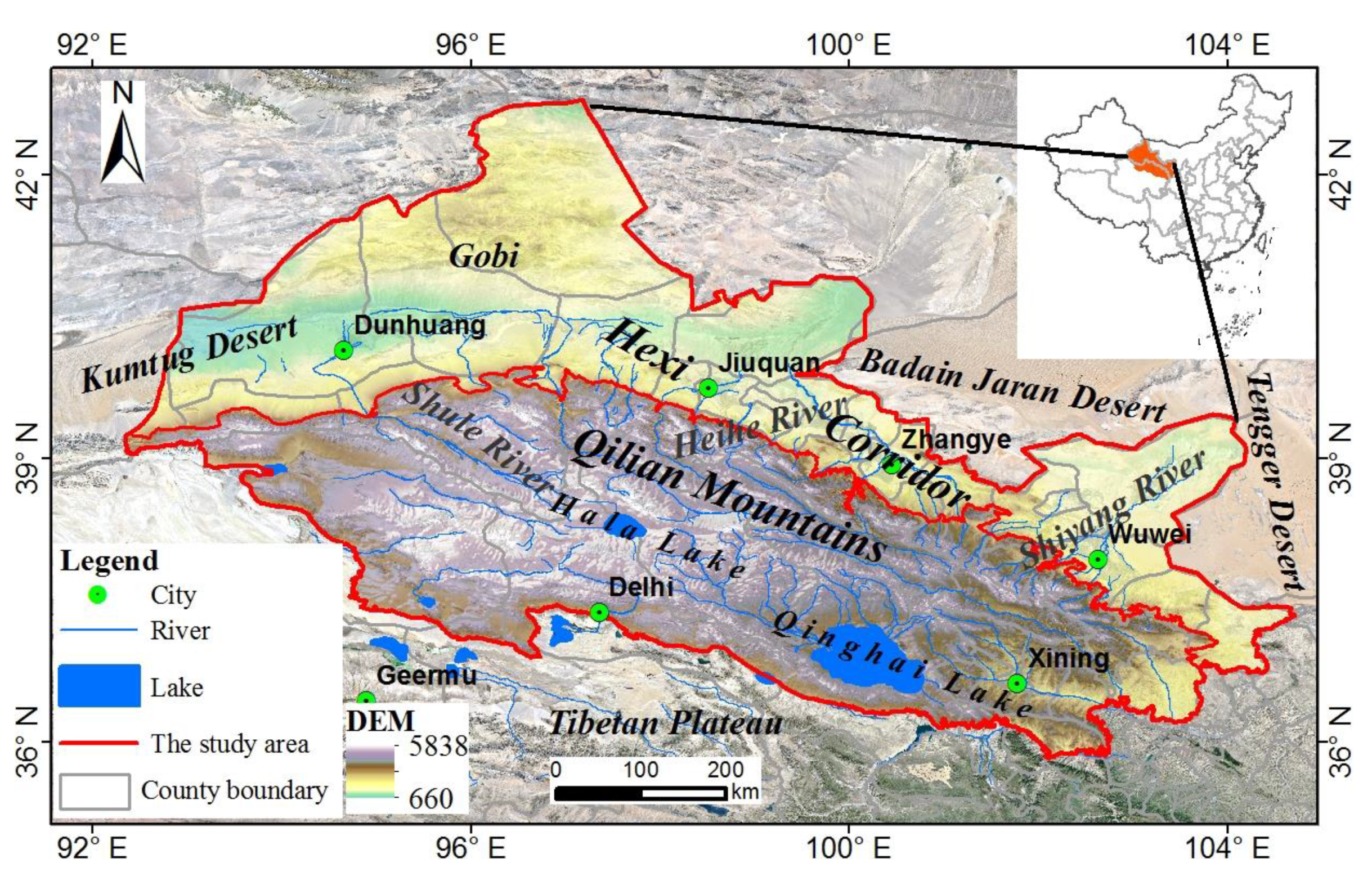
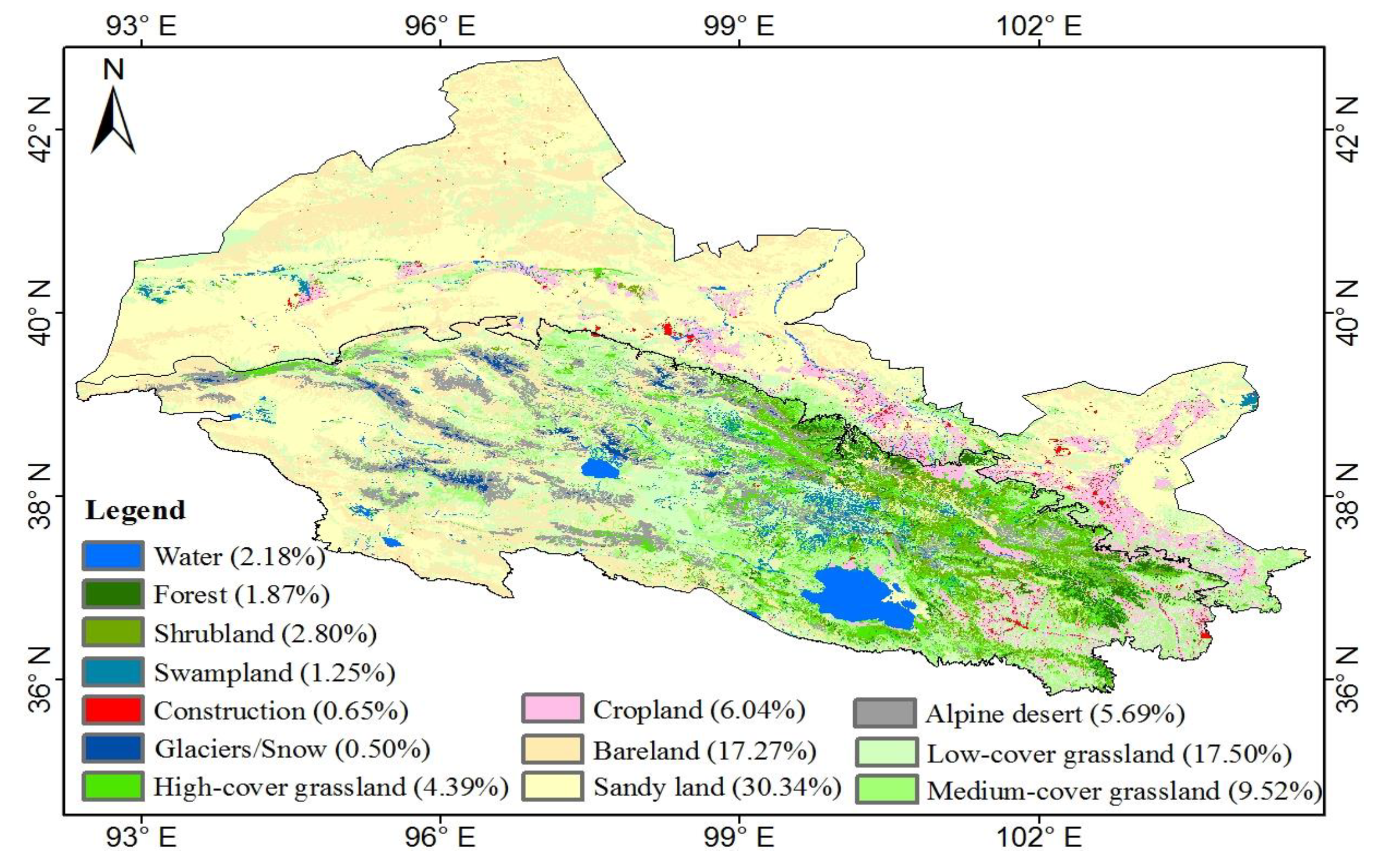
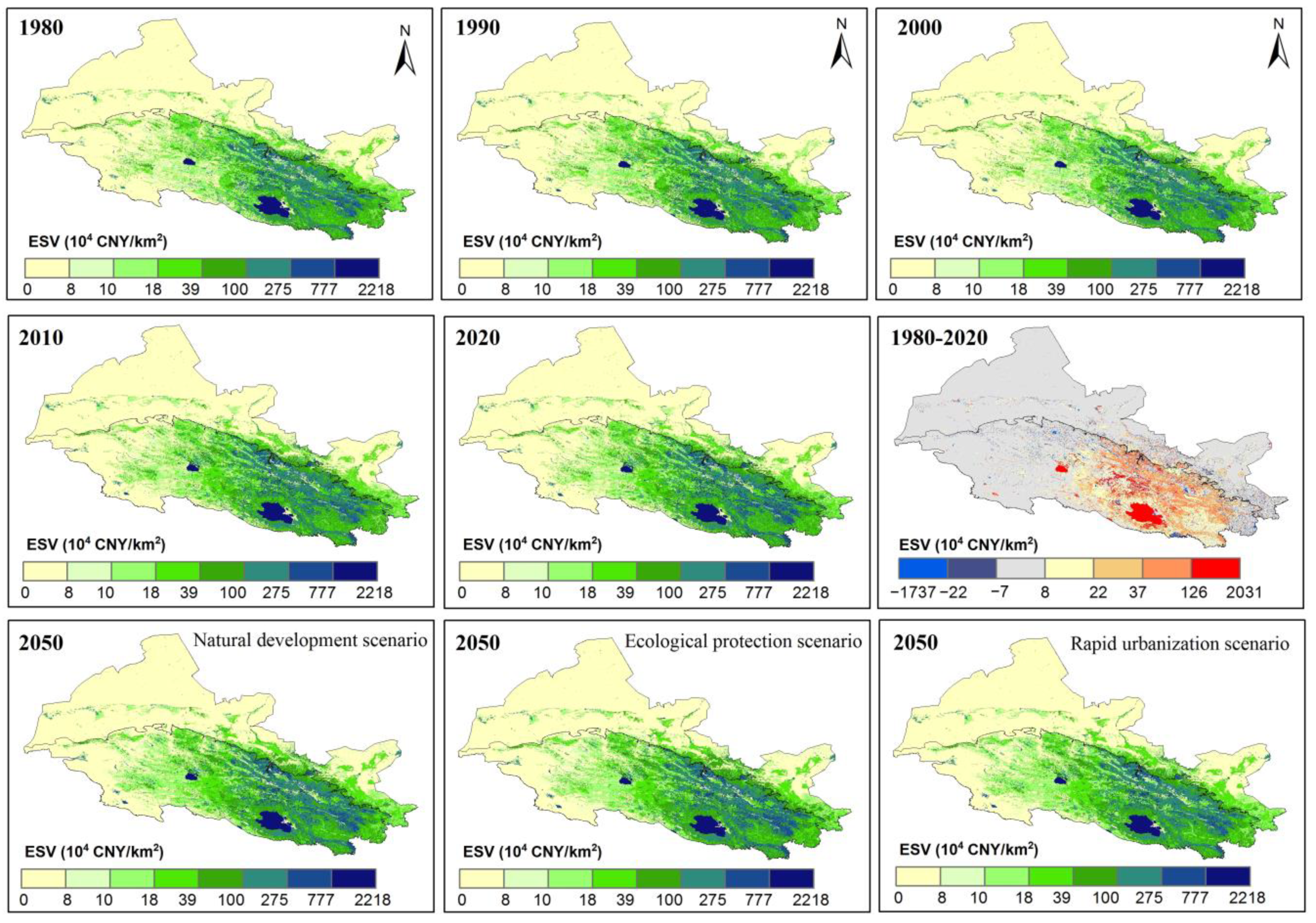
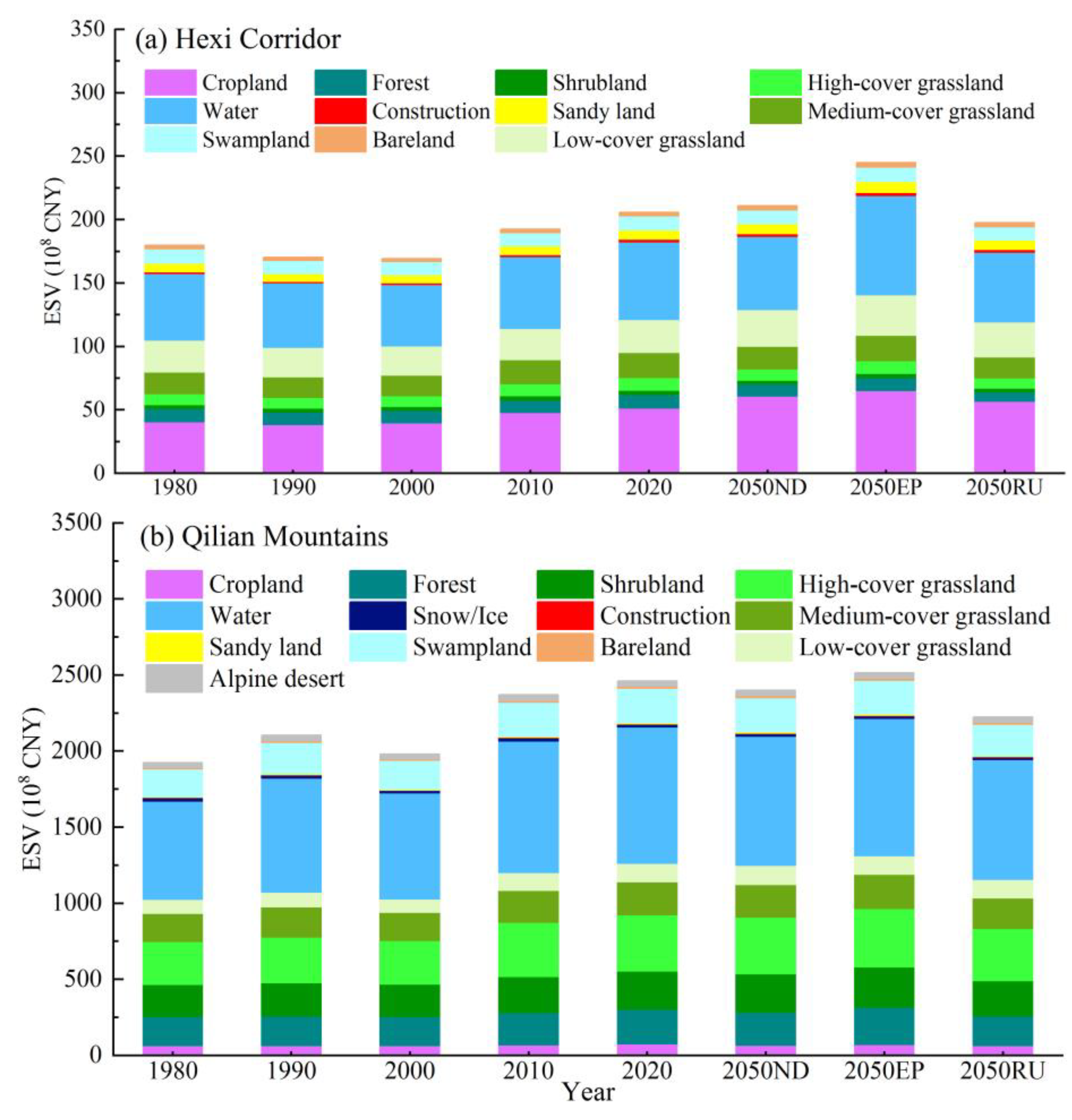
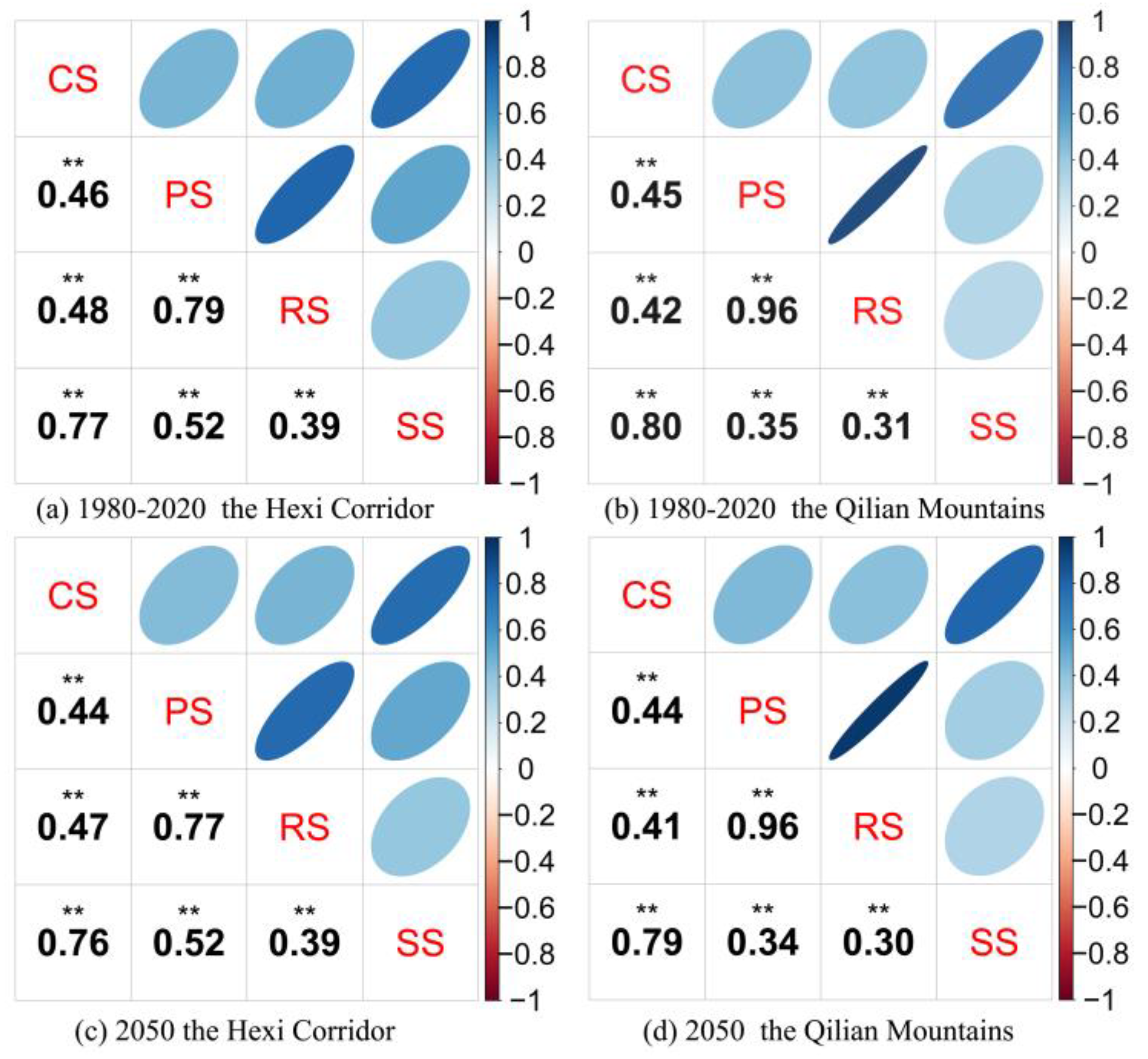
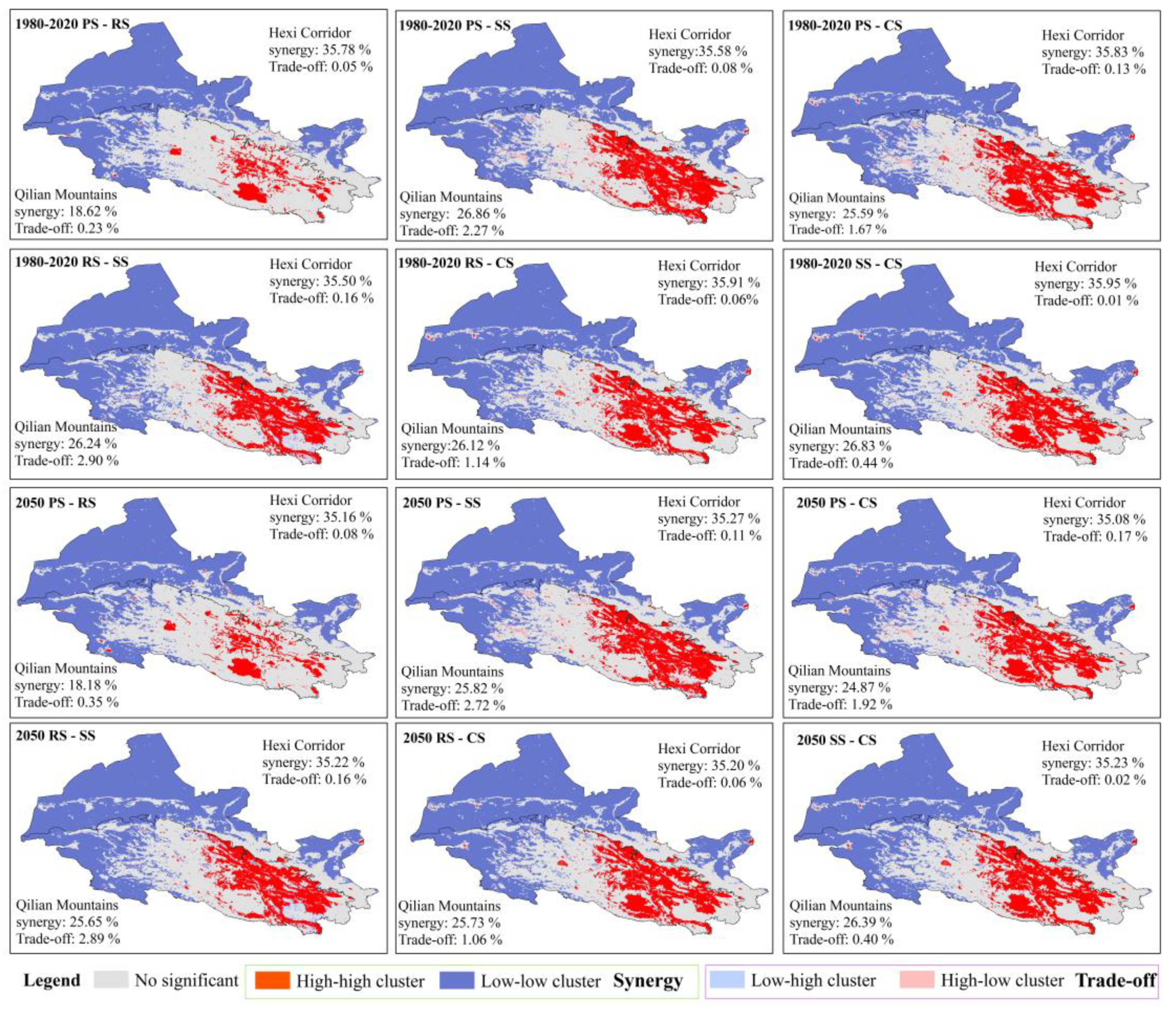
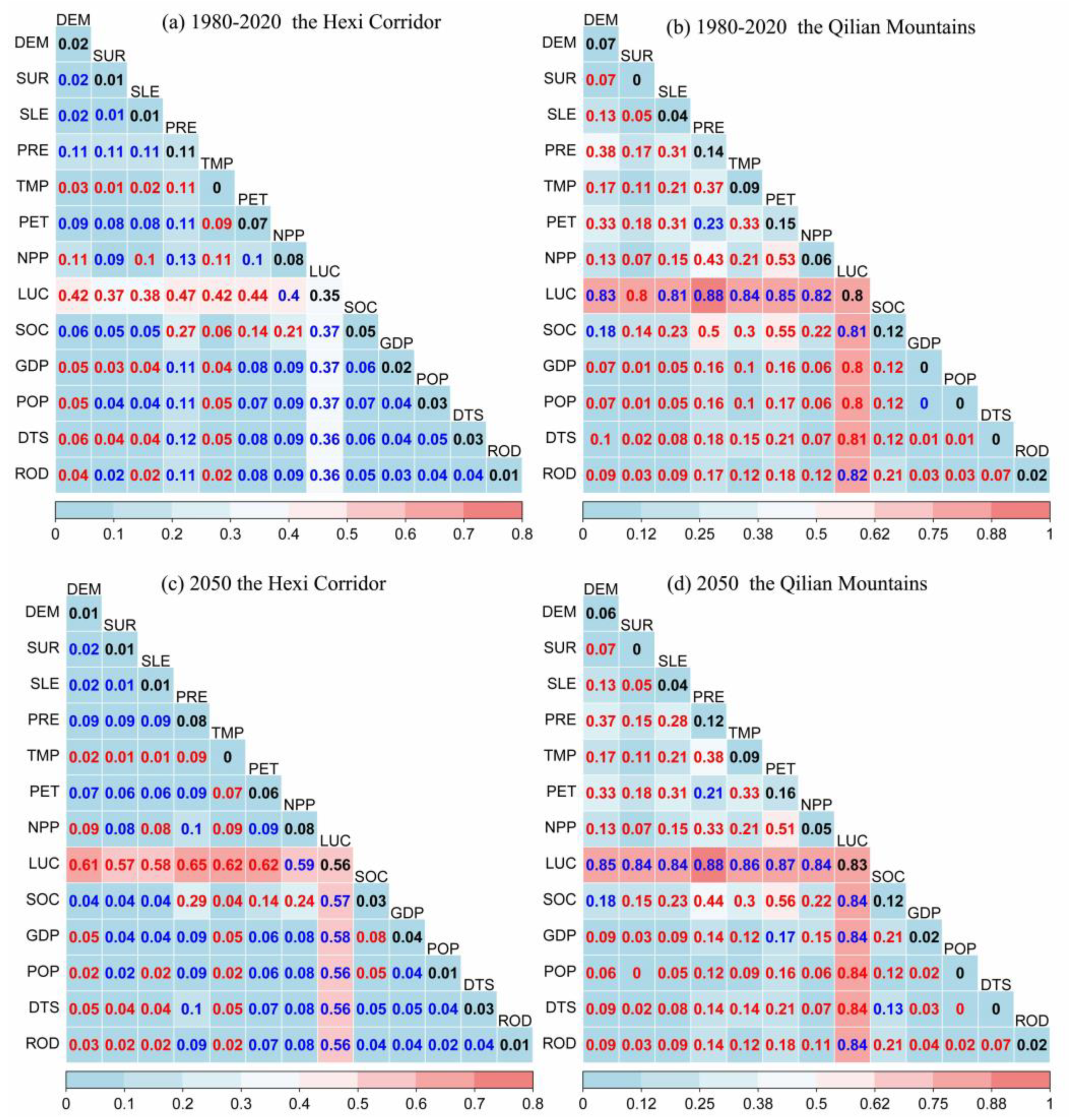
| Type | Variables (Resolution) | Source |
|---|---|---|
| LUCC | 1980–2020 LUCC datasets (1 km) | The Data Center for Resources and Environmental Sciences, Chinese Academy of Sciences (RESDC) (http://www.resdc.cn (accessed on 10 March 2022)). |
| Topography | Elevation (30 m) | Geospatial Data Cloud (http://www.gscloud.cn (accessed on 23 June 2021)). The slope and surface roughness were obtained from the elevation data. |
| Surface roughness (30 m) | ||
| Slope (30 m) | ||
| Climate | 1980–2020 Potential evapotranspiration (1 km) | Potential evapotranspiration (1980–2020) was calculated by the Penman–Monteith equation with meteorological data from the China Meteorological Data Service Center (CMDC) (http://data.cma.cn/ (accessed on 23 June 2021)) [47]. |
| 1901–2100 Temperature dataset (1 km) | 1 km monthly temperature and precipitation dataset for China from 1901–2100 [46,48,49] (http://data.tpdc.ac.cn (accessed on 10 May 2022)). | |
| 1901–2100 Precipitation dataset (1 km) | ||
| Vegetation | 2000–2020 NPP (500 m) | The U.S. Geological Survey (USGS) and the National Aeronautics and Space Administration (NASA) (https://lpdaac.usgs.gov/ (accessed on 20 July 2022)). |
| 1986–2020 NDVI (30 m) | National Tibetan Plateau Data Center (http://data.tpdc.ac.cn (accessed on 23 June 2021)). The fractional vegetation coverage was calculated using the NDVI dataset. | |
| Soil | 2018 Soil organic carbon density (30 m) | National Cryosphere Desert Data Center [50] (http://www.ncdc.ac.cn (accessed on 30 September 2021)). |
| Traffic network | 2015 Road density (1:1 million) | National Basic Geographic Database (https://mulu.tianditu.gov.cn/ (accessed on 25 June 2021)). |
| County points data | 2015 Distance to settlement (1:1 million) | |
| Population | 1990–2100 Population (POP) | The GDP and POP gridded dataset at 1 km and 0.5° resolution were acquired from the Resources and Environment Science Data Center of the Chinese Academy of Sciences (RESDC) (http://www.resdc.cn/ (accessed on 25 June 2021)) and Science Data Bank [51] (http://cstr.cn/31253.11.sciencedb.01683 (accessed on 15 May 2022)), respectively. |
| Economy | 1990–2100 Gross Domestic Product (GDP) |
| Ecosystem Services | 1980 | 2020 | Changes (1980–2020) | |||||||
|---|---|---|---|---|---|---|---|---|---|---|
| Primary Types | Secondary Types | HX | QM | Total | HX | QM | Total | HX | QM | Total |
| Provisioning Services | Food supply | 11.42 | 32.60 | 44.02 | 14.27 | 39.44 | 53.71 | 2.85 | 6.84 | 9.69 |
| Raw material supply | 6.84 | 36.56 | 43.40 | 8.29 | 44.17 | 52.46 | 1.44 | 7.61 | 9.05 | |
| Water supply | 6.17 | 88.28 | 94.45 | 7.01 | 113.44 | 120.45 | 0.83 | 25.16 | 26.00 | |
| Subtotal | 24.44 | 157.44 | 181.87 | 29.56 | 197.05 | 226.62 | 5.13 | 39.62 | 44.74 | |
| Regulating Services | Gas regulation | 14.90 | 115.20 | 130.09 | 17.63 | 139.59 | 157.22 | 2.73 | 24.39 | 27.12 |
| Climate regulation | 22.52 | 292.35 | 314.88 | 25.28 | 354.46 | 379.74 | 2.76 | 62.10 | 64.86 | |
| Environment purification | 9.33 | 111.77 | 121.09 | 10.27 | 137.07 | 147.34 | 0.94 | 25.30 | 26.25 | |
| Hydrological regulation | 75.27 | 871.75 | 947.01 | 85.62 | 1164.82 | 1250.44 | 10.35 | 293.07 | 303.42 | |
| Subtotal | 122.02 | 1391.06 | 1513.08 | 138.80 | 1795.93 | 1934.74 | 16.79 | 404.87 | 421.66 | |
| Supporting Services | Soil conservation | 15.04 | 154.04 | 169.08 | 17.10 | 197.48 | 214.58 | 2.06 | 43.44 | 45.50 |
| Maintaining nutrient cycling | 2.07 | 11.71 | 13.78 | 2.51 | 14.16 | 16.67 | 0.44 | 2.45 | 2.89 | |
| Biodiversity | 10.80 | 141.80 | 152.61 | 11.89 | 173.00 | 184.89 | 1.09 | 31.19 | 32.28 | |
| Subtotal | 27.91 | 307.56 | 335.47 | 31.50 | 384.64 | 416.14 | 3.59 | 77.08 | 80.67 | |
| Cultural services | Aesthetic landscape | 5.24 | 69.09 | 74.33 | 5.75 | 84.47 | 90.23 | 0.51 | 15.38 | 15.89 |
| Total | 179.61 | 1925.15 | 2104.76 | 205.62 | 2462.10 | 2667.72 | 26.01 | 536.95 | 562.96 | |
| Ecosystem Services | 2050 ND | 2050 EP | 2050 RU | Changes (2020–2050) | |||||||||
|---|---|---|---|---|---|---|---|---|---|---|---|---|---|
| Primary Type | Secondary Types | HX | QM | Total | HX | QM | Total | HX | QM | Total | NG | EP | UD |
| Provisioning Services | FS | 16.53 | 37.75 | 54.28 | 17.82 | 39.37 | 57.19 | 15.43 | 35.64 | 51.07 | 0.56 | 3.48 | −2.64 |
| RMS | 9.34 | 43.24 | 52.58 | 10.11 | 45.21 | 55.32 | 8.71 | 40.40 | 49.11 | 0.12 | 2.86 | −3.35 | |
| WS | 6.93 | 110.13 | 117.06 | 8.66 | 114.54 | 123.20 | 6.53 | 102.87 | 109.40 | −3.38 | 2.76 | −11.05 | |
| Subtotal | 32.81 | 191.12 | 223.92 | 36.59 | 199.12 | 235.71 | 30.68 | 178.91 | 209.58 | −2.70 | 9.09 | −17.04 | |
| Regulating Services | GR | 19.26 | 137.87 | 157.12 | 20.92 | 143.93 | 164.86 | 17.89 | 128.51 | 146.39 | −0.09 | 7.64 | −10.82 |
| CR | 25.61 | 352.07 | 377.67 | 28.17 | 368.41 | 396.57 | 23.53 | 327.03 | 350.56 | −2.07 | 16.83 | −29.19 | |
| EP | 10.53 | 136.03 | 146.57 | 11.84 | 141.54 | 153.39 | 9.84 | 126.64 | 136.48 | −0.77 | 6.04 | −10.86 | |
| HR | 84.98 | 1123.39 | 1208.37 | 106.39 | 1181.50 | 1287.89 | 80.13 | 1040.21 | 1120.34 | −42.07 | 37.45 | −130.10 | |
| Subtotal | 140.38 | 1749.35 | 1889.73 | 167.33 | 1835.38 | 2002.70 | 131.38 | 1622.38 | 1753.76 | −45.00 | 67.97 | −180.98 | |
| Supporting Services | SC | 17.07 | 189.63 | 206.70 | 18.16 | 200.51 | 218.67 | 16.33 | 172.91 | 189.24 | −7.88 | 4.08 | −25.34 |
| MNC | 2.81 | 13.89 | 16.70 | 3.04 | 14.51 | 17.55 | 2.62 | 12.98 | 15.60 | 0.03 | 0.88 | −1.07 | |
| BIO | 12.03 | 171.78 | 183.80 | 13.26 | 178.23 | 191.48 | 11.13 | 159.65 | 170.78 | −1.09 | 6.59 | −14.12 | |
| Subtotal | 31.91 | 375.30 | 407.21 | 34.46 | 393.24 | 427.70 | 30.07 | 345.54 | 375.61 | −8.94 | 11.56 | −40.53 | |
| Cultural services | AL | 5.82 | 83.81 | 89.63 | 6.43 | 86.75 | 93.18 | 5.39 | 77.93 | 83.33 | −0.60 | 2.96 | −6.90 |
| Total | 210.91 | 2399.58 | 2610.49 | 244.81 | 2514.48 | 2759.29 | 197.52 | 2224.76 | 2422.28 | −57.23 | 91.57 | −245.45 | |
| Factors | 1980-2020 | 2050 | ||||||
|---|---|---|---|---|---|---|---|---|
| Hexi Corridor | Qilian Mountains | Hexi Corridor | Qilian Mountains | |||||
| q-Value | p-Value | q-Value | p-Value | q-Value | p-Value | q-Value | p-Value | |
| DEM | 0.019 | 0.000 | 0.066 | 0.000 | 0.013 | 0.000 | 0.064 | 0.000 |
| SUR | 0.007 | 0.000 | 0.002 | 0.000 | 0.006 | 0.000 | 0.002 | 0.000 |
| SLE | 0.009 | 0.000 | 0.043 | 0.000 | 0.006 | 0.000 | 0.045 | 0.000 |
| PRE | 0.108 | 0.000 | 0.143 | 0.000 | 0.084 | 0.000 | 0.117 | 0.000 |
| TMP | 0.005 | 0.000 | 0.094 | 0.000 | 0.004 | 0.000 | 0.091 | 0.000 |
| PET | 0.072 | 0.000 | 0.153 | 0.000 | 0.059 | 0.000 | 0.155 | 0.000 |
| NPP | 0.085 | 0.000 | 0.055 | 0.000 | 0.076 | 0.000 | 0.053 | 0.000 |
| LUC | 0.354 | 0.000 | 0.801 | 0.000 | 0.557 | 0.000 | 0.835 | 0.000 |
| SOC | 0.046 | 0.000 | 0.120 | 0.000 | 0.034 | 0.000 | 0.123 | 0.000 |
| GDP | 0.024 | 0.000 | 0.001 | 0.000 | 0.038 | 0.000 | 0.019 | 0.000 |
| POP | 0.034 | 0.000 | 0.000 | 0.000 | 0.010 | 0.000 | 0.000 | 0.000 |
| DTS | 0.033 | 0.000 | 0.004 | 0.000 | 0.034 | 0.000 | 0.004 | 0.000 |
| ROD | 0.014 | 0.000 | 0.019 | 0.000 | 0.014 | 0.000 | 0.019 | 0.000 |
Publisher’s Note: MDPI stays neutral with regard to jurisdictional claims in published maps and institutional affiliations. |
© 2022 by the authors. Licensee MDPI, Basel, Switzerland. This article is an open access article distributed under the terms and conditions of the Creative Commons Attribution (CC BY) license (https://creativecommons.org/licenses/by/4.0/).
Share and Cite
Li, Y.; Liu, W.; Feng, Q.; Zhu, M.; Zhang, J.; Yang, L.; Yin, X. Spatiotemporal Dynamics and Driving Factors of Ecosystem Services Value in the Hexi Regions, Northwest China. Sustainability 2022, 14, 14164. https://doi.org/10.3390/su142114164
Li Y, Liu W, Feng Q, Zhu M, Zhang J, Yang L, Yin X. Spatiotemporal Dynamics and Driving Factors of Ecosystem Services Value in the Hexi Regions, Northwest China. Sustainability. 2022; 14(21):14164. https://doi.org/10.3390/su142114164
Chicago/Turabian StyleLi, Yongge, Wei Liu, Qi Feng, Meng Zhu, Jutao Zhang, Linshan Yang, and Xinwei Yin. 2022. "Spatiotemporal Dynamics and Driving Factors of Ecosystem Services Value in the Hexi Regions, Northwest China" Sustainability 14, no. 21: 14164. https://doi.org/10.3390/su142114164
APA StyleLi, Y., Liu, W., Feng, Q., Zhu, M., Zhang, J., Yang, L., & Yin, X. (2022). Spatiotemporal Dynamics and Driving Factors of Ecosystem Services Value in the Hexi Regions, Northwest China. Sustainability, 14(21), 14164. https://doi.org/10.3390/su142114164










